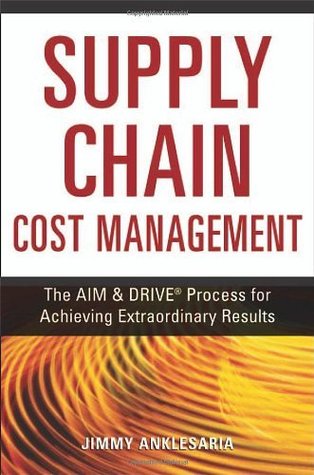Supply Chain Cost Management Summary

5 min read ⌚

The Aim & Drive Process for Achieving Extraordinary Results
It’s rarely a problem when you have a sales increase, but what about your costs?
It’s best if we start from the beginning.
We briefly summarize Anklesaria’s methods and proudly present this comprehensive outline of “Supply Chain Management.”
Who Should Read “Supply Chain Cost Management”? And Why?
In reality, the embodiment of team success is finding the gap in a system that creates “tension.” As soon as you overcome that problem, the company should be able to perceive things from a different perspective.
With this in mind, we warmly advise management students, and knowledge seekers to read “Supply Chain Cost Management.”
About Jimmy Anklesaria
 Jimmy Anklesaria is an author, and also a cost-management expert, who over the years shared many insightful tips with the audience on cost-reduction. He was hired by many innovative companies to conduct seminars in order to reveal some of the fundamentals on the subject.
Jimmy Anklesaria is an author, and also a cost-management expert, who over the years shared many insightful tips with the audience on cost-reduction. He was hired by many innovative companies to conduct seminars in order to reveal some of the fundamentals on the subject.
“Supply Chain Cost Management Summary”
Nowadays, companies spend more time trying to figure out a way to reduce costs, then attempting to increase sales.
Such approach isn’t entirely clear, so let’s hit the books and investigate why. In general, we believe almost any person is aware, that cost control is not an optional process, not only it’s mandatory but highly essential.
However, not many enterprises have mastered the technique to control and ultimately reduce them. Regardless of the type, it’s only logical to aim at the decrease, and consequently earn higher profits.
How it all started at IBM:
Right after, things began to get a little rough, Lou Gerstner and Gene Richter both experts in various fields were brought to the company to inspire every organizational layer to apply a new system by which all sectors will become cost-centric.
This resulted in an immediate turn for the better. The real question is – What was this strategy all about?
The goal was to follow one highly efficient and simple program – the five-step plan known as “The Cost Reducer” because in every step there was the same objective.
Afterwards, the procurement team of experts had no other choice than to really indulge this method, designed by the supply chain expert Gene Richter.
IBM took over the market by increasing their profits and gaining a competitive edge.
Here’s the deal:
Don’t go running around if you don’t have the expertise; it’s always better to rely on outside help, in order to reduce costs in the long-run. The real issue most companies have is slightly linked to their ignorance about the cost structure.
Are you aware that one mistake pulls others, a misleading information can produce supply chain issue and so on?
For that purpose, we present or in this case – Jimmy Anklesaria gives you the “Aim & Drive” process. A great way to start working on cost-reduction – an eight-step process ready to take your supply chain knowledge, to the next level. The ultimate goal is linked to satisfied end-customers at a smaller price!!
Let’s start counting:
-
- “Agreeing” to foresee and thereby reduce any unexpected costs with a practical supply-chain attitude.
-
- “Identifying” when new costs give birth to others, and you develop a strategy with your suppliers to collectively deal with this mess.
-
- “Measuring” also categorized as second-class costs, in other words – not so important.
-
- “Defining” understanding the cost drivers driven by previously defined strategic options.
-
- “Reducing,” revamping those processes or activities that are responsible for these costs.
-
- “Implementing” The new foundation, that you’ll build on – the action plan.
-
- “Verifying” Approval of the strategy and begin monitoring any unwanted cost fluctuations.
- “Eternally” redesign the cost structure and process selection.
The team of experts especially those in charge of the supply chain, should begin analyzing the project’s feasibility and define goals.
Which directions should you follow?
There are several things that you should not consider doing. For example, what is the purpose of lowering supply chain costs, if in the near future you’ll pump up those numbers by accepting inferior goods or commodities at a greater expense? You have to have a vision.
“Supply Chain Cost Management” suggest each company to track the progress in a specially designed worksheet, where anyone with access can gain insights and up-to-date information.
Key Lessons from “Supply Chain Cost Management”
1. The recreation of a map
2. Several ways to measure success
3. Think twice about cost-reduction
The recreation of a map
First and foremost, any company should focus on mapping those processes which are the greatest contributors to the “cost-table.”
Only then, you can consider about removing some of them, or embark on a full-scale remodeling journey.
In either case, listing all these elements will give you the upper hand in the struggle to cope with cost increases!!
Several ways to measure success
Generally speaking, to launch an evaluation process, the company must own, possess, installed or have in store, at least one of two systems – allocation or management – based system.
It’s not forbidden to use others, but most firms depend on these.
Allocation systems, on one hand, are highly dependable of applying cost-figures to company’s products or services, while management systems are more open to various types of evaluation models, plenty of alternatives.
Think twice about cost-reduction
Don’t be surprised to know how many companies come to a stage, where they can really put their skills to the test, and then hesitate to act.
Even though they have all the help in the world from both suppliers and customers, they do nothing.
If you wish to avoid a similar scenario, you need to create an effective plan and stick to it, no matter what. Make sure it’s realistic, and feasible so that it speaks on everyone’s behalf – in other words, verify that all employees are comfortable with it.
Like this summary? We’d Like to invite you to download our free 12 min app, for more amazing summaries and audiobooks.
“Supply Chain Cost Management” Quotes
The journey of cost management...never ends. I have yet to see a company that sends a message to its supply chain saying, ‘We are making too much money, please stop managing cost. Share on X As strategies are completed...document, to the best of your ability, the monetary savings. Share on X Customer-supplier relationships can become partnerships or strategic alliances where there is a common focus on improving yields at the customer’s site. Share on X The key question to ask about improving a cost driver...is: ‘Will the technology, quality, safety, cycle time, or total cost of the product or service be jeopardized if you achieve the theoretical limit. Share on X The real power of cost management is to know from the creation of a new part, product or service what the true purchased costs are. Share on XOur Critical Review
This book emphasizes the importance of a relationship, neglected by many – the bond between companies and suppliers. In our opinion, cost-reduction is the topic of the century, so in this case, we believe that “Supply Chain Cost Management” has the perfect material in store – on this problematic.








